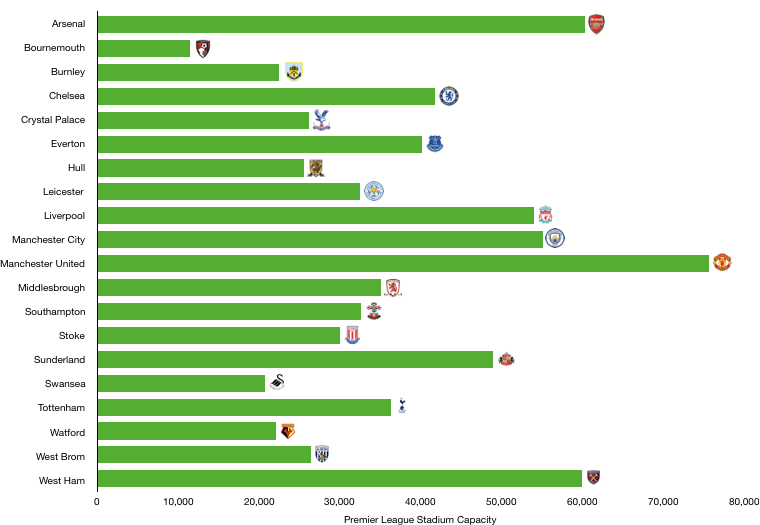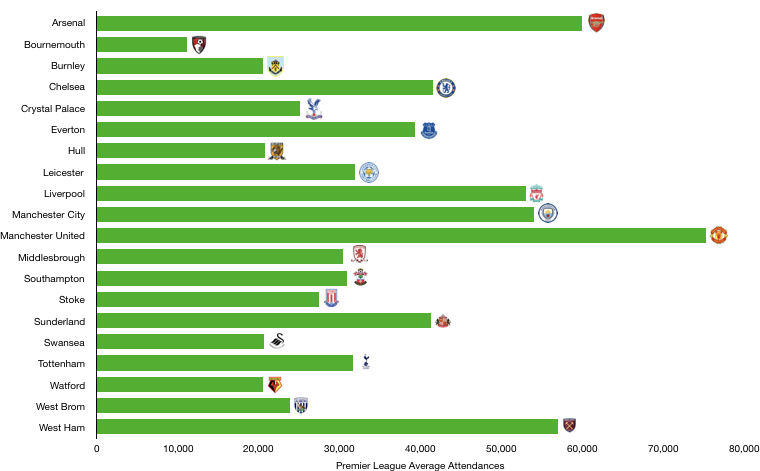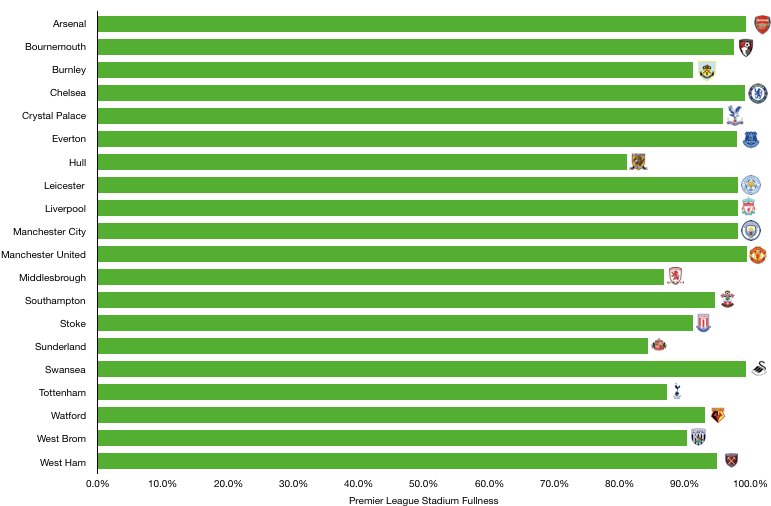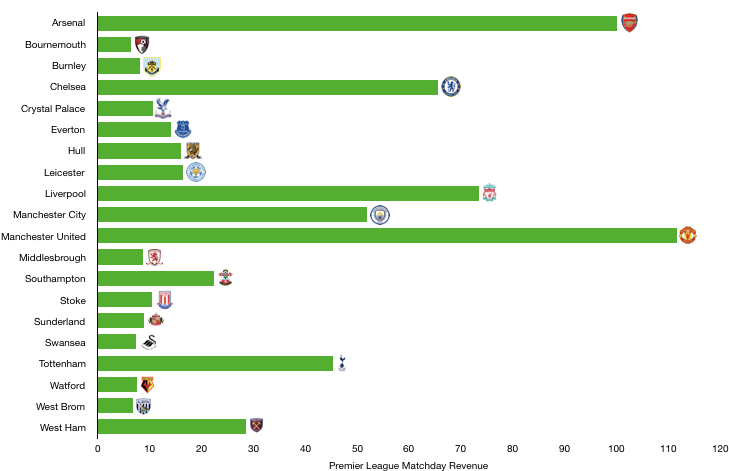This is the third and final instalment of our Premier League revenue analysis for the 2016/17 season. As mentioned, Premier League clubs release their financial results 12 months after the end of the season it relates hence why we cannot yet analyse the 2017/18 season.
The Premier League has year after year grown its commercial presence, monetizing the commercial side of the game to huge heights. This has seen matchday revenue shrink in importance, with clubs less reliant on matchday takings than previously. Matchday revenue can however bring a financial advantage to those sides that can bring in the crowds due to their popularity, stadium capacity and ticket prices. The differences can be stark with the highest taking being £112m (Manchester United) and lowest being £6.5m (Bournemouth).
Matchday revenue consists of ticket sales, hospitality and food/beverage sales on matchdays.
This is a slow growth area with growth of 6.5% in 2016 with £621m taken on matchdays last season.
This article analyses Premier League matchday revenue, lets delve into the numbers.
Who’s Up, Who’s Down?

As already mentioned, Matchday revenue growth is much slower than Commercial and Broadcasting revenue growth. This is down to various factors. Naturally, matchday revenue is constrained by stadium capacity, with this remaining fairly static for the majority of clubs with only a handful likely to have increased capacity from one season to another. This means the main way to increase matchday takings is to increase prices, a delicate strategy which may upset fans, this has led to the majority of club’s freezing ticket prices in the past year.
Therefore, clubs have to rely on supporters spending a greater deal in the stadiums or progressing further in cup competitions in order to have more matchdays. The growth of matchday revenue has been dampened by the introduction of the Premier League away day cap this season, meaning Premier League clubs cannot charge more than £30 for any away game from the 2016/17 season onwards, reducing the away day income for clubs.
The three promoted Championship sides Burnley, Hull and Middlesbrough unsurprisingly saw matchday revenue rise as they filled their grounds to a greater extent and were able to charge higher prices than previously. Hull saw an unprecedented 75% rise in matchday revenue to £16.1m as their fans excitement was showcased dramatically for their ultimately short-lived Premier League stay. Burnley saw matchday revenue grow 24% to a modest £8.2m while Middlesbrough saw revenue rise 19% to a similar level at £8.7m. This shows the incredible riches of gaining promotion to the Premier League, with all promoted clubs experiencing sizeable jumps in all sources of revenue.
Leicester after their incredible Premier League winning campaign saw matchday revenue rise 42% to £16.5m as the club had more games due to their Champions League exploits and were also able to charge higher prices after such an exhilarating season.
Among the other big winners were Liverpool’s £73.5m (18% increase), Southampton’s £22.4m (19%) and Tottenham’s £45.3m (11%).
Despite a brand spanking new Olympic Stadium, West Ham saw a modest 6% rise in matchday revenue as the East London club were forced to charge lower ticket prices to increase attendances.
On the other end of the scale, Everton saw a sharp 20% drop in matchday revenue to £14.1m as they froze ticket prices and attendance fell after a couple of mediocre seasons for the club.
Also struggling were Crystal Palace’s £10.6m (-11% decrease), Stoke’s £10.5m (-13%), Sunderland’s £9.0m (-14%), Watford’s £7.6m (-10%) and West Brom’s £6.8m (-12%).
Manchester City surprisingly saw a slight drop of 1.1% to £51.9m as the number of games dropped while Manchester United saw a modest rise of 4.4% to £111.6m. Arsenal stayed pretty much stable at £100m. Chelsea saw the biggest drop among the top 6 as matchday revenue fell 6% on the back of having no European football, something the fans will not be too unhappy with after storming to the Premier League title.
Big Enough?

As we have already mentioned, matchday revenue is constrained by stadium capacity with the sheer imbalance in stadium sizes a major factor in the stark difference in matchday income of Premier League clubs.
Manchester United continue to hold the largest stadium in English club football with Old Trafford holding 75,731 fans, enabling the Manchester club to clean up on matchdays.
They are followed by Arsenal (60,362) and now West Ham (60,000) after they moved into the Olympic Stadium who will be hoping to see matchday revenue increase sizeably in the future due to this move.
Manchester City (55,097) and Liverpool (54,074) are the only other sides with capacity above 50,000 with the other big London clubs failing to find the space as of yet to increase capacity, however this is due to change soon (see current developments below).
At the end of the scale is Bournemouth by a distance with a capacity of 11,464 currently after their rapid rise through the divisions. This small ground is a major constraint to Bournemouth ever increasing matchday revenue which isn’t easily fixable for a club of Bournemouth’s current stature.
The only other Premier League clubs with capacity below 30,000 are Burnley (22,546), Crystal Palace (26,255), Hull (25,586), Swansea (20,750) and Watford (26,445) who all struggle to increase matchday income to any degree (except where promotions are involved).
Half Empty or Half Full?

It is one thing having large capacity, it’s another to fill it. The average capacity % is a high 93.9% full, with Sunderland and Hull being the only clubs to be less than 85% full last season at 84.3% and 81.1% respectively.
The average attendance for Premier League games last season was a modest 35,821 supporters with this pulled in two directions by clubs with opposing stadium sizes.
Manchester United had the highest average attendance unsurprisingly at 75,290 and Bournemouth the lowest at 11,182.

The fullest stadium last season was surprisingly Swansea as 20,619 (99.4%) as fans watched them successfully avoid relegation (in the short term) and Manchester United at 75,290 (99.4%). Swansea and Manchester United were closely followed by Arsenal at 59,957 (99.3%) and Chelsea at 41,508 (99.2%).
Liverpool at 53,016 and Manchester City at 54,019 lagged their rivals slightly at 98% capacity.
Tottenham surprisingly had a fairly empty stadium with only 31,639 (87.2%) fans attending their games on average, another area they lag their rivals and will be hoping to remedy with their stadium move and continued success domestically.
Matchday Summary

Unsurprisingly, Manchester United lead the way in matchday income with an eye watering £111.6m in revenue with Arsenal the only other club to be in the £100m club with exactly £100m in the matchday revenue.
Behind them is the other two members of the traditional top 4 in Liverpool (£73.5m) and Chelsea (£65.5m) as their global level of support and growing fan bases allowing them to charge more than their rivals.
Manchester City are trying to catch their rivals with £51.9m in matchday revenue, less than half Manchester United’s, while Tottenham lag also with only £45.3m in revenue.
At the other end of the scale is Bournemouth (£6.5m), Burnley (£8.2m), Middlesbrough (£8.7m), Sunderland (£9.0m), Swansea (£7.4m), Watford (£7.6m) and West Brom (£6.8m) being the clubs with matchday revenue below £10m.
This can all change relatively quickly once stadium expansions or redevelopments take place, transforming a club’s matchday earning potential considerably. Let’s look at what clubs are currently doing in this regard…
Current Developments
Bournemouth are unsurprisingly looking at building a new stadium with King’s Park being the desired location. The club is drawing up plans currently.
Chelsea were looking at redeveloping Stamford Bridge to a 60,000-seater stadium, however plans have been halted recently with Abramovich having political issues.
Crystal Palace were recently given the green light for a £100m redevelopment of Selhurst Park , increasing the main stand from a capacity of 5,400 to 13,500.
Everton have begun talks over a new stadium however not much has occurred to date.
Liverpool last year increased capacity to just over 54,000, the club now plan to expand seats by a further 7,000.
Tottenham are temporarily living at Wembley as the New White Hart Lane is built after a series of delays led to the stadium not being ready for the beginning of this season.
Watford have begun exploring ways to expand Vicarge Road to over 30,000 seats.
Thanks for reading, share with your friends!


Thank you so much dear!andy kaufman tony